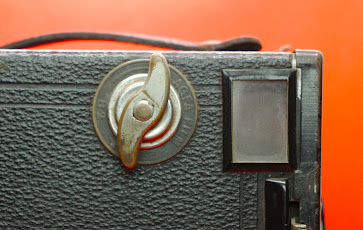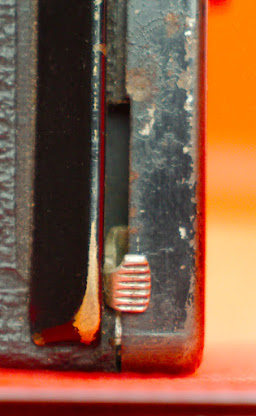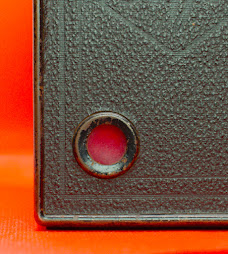Good news! My Displate store is online with 10 posters and more on the way.
So for a metal print of my drawings on Displate: https://displate.com/artist/BFennSW?art=66e809bf952d9
Please note that I have closed my Picfair store, but you can now buy my pictures on my Patreon: patreon.com/OnlineCurator
Thank you for the support. Anyway, back to your regularly scheduled programming:
This post will be looking at another Agfa camera, but unlike the previous three, this camera is a simpler box camera. This is the Agfa Box 54.
Agfa
made many different box cameras starting in 1930-1957 (Spickmann). According to
Before Digital (2022), Agfa manufactured box cameras to boost their film sales.
For box cameras are inexpensive to make, they could be sold cheaply and in some
cases, users were told to only use a specific type of film sold by the camera
company. In this case it is Agfa’s B-2 film.
.jpeg) |
| Agfa B2 film. Image Source: https://www.collection-appareils.fr/agfa/images/B2.JPG |
In
other words: “…like how modern-day printer manufacturers quite often make cheap
printers in order to then sell the ink…” (Before Digital 2022).
And
according to Camera-wiki, the sales of the 120 film, helped Agfa recuperate
their loses when it came to selling the box cameras at a cheap rate. One thing
that could have driven Agfa to focus on box cameras was WWII. As mentioned in
my Agfa Clack post, Agfa was involved in the war effort, and thus could have
been incentivised to make cheap cameras that were easy to use. One piece of
evidence that could support this comes from IWM (2025), that mentions the Agfa
box cameras were “…Popular amateur camera used by German Forces during the
Second World War…”
One
thing I also found interesting, is that according to camerassinfronteras.com,
this camera, the Box 54, is the first box camera made by Agfa. It was also sold
alongside the Box 64 (or the Box Spezial). But the 54 is known as the “simpler”
of the two and was made in 1930-1933 (Camera-wiki).
.jpeg) |
| Agfa Box 64 (Box Spezial). Image Source: http://vieilalbum.com/Box64spezialUS.htm |
The
cameras were released because of the 1929 economic crash that lead to Agfa
having to reduce costs in camera production, thus “…already begun this strategy
shortly before with its ‘Billy’ series of inexpensive folding cameras
(‘Billy’ was the subliminal way of saying ‘cheap’ - billig - in German), and
they continued to produce box cameras. Thus, in September 1930, after an
initial launch with another box camera in England, they announced their first
‘Box Camera,’…” (camerassinfronteras.com). See my Agfa Billy Record post for more information.
The
cameras proved to be successful, selling 44000 units when released during
Christmas time, and then selling another 160000 more the next year. Agfa’s
sales grew even more when they introduced the Box 44 to replace the 54 and 64,
which was stopped in 1933 when they released the newer variations, called the
Box 54 “Box I” (camerassinfronteras.com). After that Agfa released a few more
cameras, such as the Agfa Synchro box 600 (Spickmann) and the Agfa Box 94 “B-2”
(camerassinfronteras.com).
.png) |
| Agfa Box 54 "Box I". Image Source: https://www.udospickmann.de/agfa-boxkamera |
 |
| Agfa Synchro Box 600. Image Source: https://farm1.static.flickr.com/245/452675926_f96760fd66.jpg |
.jpeg) |
| Agfa Box 94 "B-2". Image Source: https://collectiblend.com/Cameras/images/AGFA-Box-94-(Box-B2).jpg |
Now,
time to have a closer look at the camera at hand, the Agfa Box 54. As mentioned
this camera is the first one of the series and was made in 1930-1933. The
camera is made from aluminium, although they would later be made from cardboard
to reduce costs (camerassinfronteras.com). The camera has a weight of 500g
(Trigeos Collectables 2024) and has the size of 4 x 3 x 5.3 inches.
The
name Box 54 doesn’t have a clear reason to why it was called that. According to
Original Werbeanzeige von 1931 (2025), this is its camera number, “Box No.54”.
But then we have camerassinfronteras.com, that points out: “Agfa used more or
less consecutive numbering for its pre-war box cameras
(04/14/24/34/41/44/45/50/54/64/84/94). This numbering, however, was not in any
chronological order. So, the first were the 54 and 64, with the 04 (Agfa Box
B-2) dating from 1937. I don't know the reasons for this ordering.”
But
there is the possibility that the name could come from the price it was sold
as. Because according to Camera-wiki the Box 44 was sold for 4 marks, which was
a part of the camera’s advertising campaign:
“In
1932, the German company Agfa had a new idea for an advertising campaign.
German coins had a printed letter stating the place of minting. He asked
customers to collect four coins of 1 marked with the letters ‘A’, ‘G’, ‘F’ and
‘A’...” (Foticos Collection 2025). So with that in mind maybe there is something
connected to the 54s name and its original selling price of 13.05 RM
(camerassinfronteras.com)?
 |
| Agfa Box 44. Image Source: https://fk-secondhand.com/wp-content/uploads/2024/06/110944_agfa_box_44_01.jpg |
Now
time to have a closer look. Starting with the front.
The
lens-
What
actually is in front is the “protective glass to prevent dust and dirt from
entering the camera's interior” (camerassinfronteras.com). Instead, like the Brownie
No.2, the lens is inside or behind the shutter. But unlike the Brownie No.2
the lens isn’t even attached to the main body, but to the film holder/carrier.
Then
above that is the viewfinders, or brilliant finders, also known as Watson-type
viewfinders (Camera-wiki), which is similar to the Brownie
Model 1, but unlike the Model 1 this camera has to be viewed at an angle
instead of directly above it (Camera-wiki).
 |
| Brilliant finder vs. a Watson-type finder. Image Source: https://farm4.static.flickr.com/3617/3477365042_152f5c5d59.jpg |
But
the placement of the finders are similar to the Model 1, in that the left side
is for portraits and the right is for landscapes.
These
viewfinders are also made from “…polished metal mirrors (not glass) used to
reflect the image through the viewfinders. The image obtained in the
viewfinders is sufficient (as long as their elements are clean), suffering, as
always with this type of viewfinder, from the problem of seeing images reversed
from left to right, which requires some practice to properly focus. The lack of
parallax correction or parallax markings in the viewfinders can play tricks on
us when shooting at close range, where the image captured on the negative will
be smaller (which will very likely 'crop' heads and feet) than what
is seen through the viewfinders…” (camerassinfronteras.com).
Now
for the side-
The Watson viewfinder that frames the subject in the landscape mode is located here.
Then next to that is the film key or advance knob, and unlike the other box cameras on this blog, it is near the top instead of the bottom. This key also locks and releases the film carrier from the main body.
Underneath
viewfinder, is the shutter speed lever setting, which like most box cameras
only has only switches between “I” that has a speed of 1/30s (camerassinfronteras.com)
and “B” that leaves the shutter open for as long as the user wants.
Then
under that is the shutter lever, which like the Brownie No.2, is like a two-way
switch. Meaning that when the user releases the shutter, by pressing down, the
lever doesn’t jump back to its original position (like the Beau
Brownie), but instead stays in that position. And if the user wants to take
another picture, they will have to press the lever upwards.
This
has both one advantage and one disadvantage. The advantage is that if the
camera is set to the B shutter setting, then the user doesn’t have to hold down
the shutter button to keep the shutter open. The disadvantage is that the user
would have to constantly change their thumb and hand position between shots.
There
is also a shield or rail that “…is supposed to protect users from possible
injuries caused by rubbing against the camera's protruding levers…”
(camerassinfronteras.com).
Now
on top-
Here
is something I am very excited about, and that is the strap! So far all the
other box cameras had the strap missing, but this one still has it. Although
broken, it is still pretty cool to see the original strap with the camera,
instead of just two empty studs.
Then
on the front of the top is the portrait viewfinder. Then next to that is the
f/stop lever.
This
lever is just like the Brownie
Beau and the No.2,
in that it is attached to a plate that has holes punched in it, making it a
Multihole aperture, just like the Sinpo
PQ-3, the Agfa
Clack and the Solar
DX-3.
But
also, unlike the Beau and the No.2, this camera actually has the f/stop sizes
pressed onto the metal lever. These f/stop settings are 12.5, 16 and 22.
Then
bottom of the top of the camera is the film compartment cover latch, similar to
the Brownie
Model 1.
Then
on the bottom and the other side of the camera are the two tripod sockets,
similar the Beau Brownie. The socket on the side is so that the camera can be
positioned to take pictures in landscape mode and bottom is for portraits.
Then
there is the back-
Here
is the film compartment cover, which has a red film counter window.
The
cover is released by lifting up the latch and pulling back.
In
the film compartment is the film carrier/holder, that still (like the Agfa
Clack) has some film in it.
 |
| Agfa Box 54 with empty film holder/carrier. Image Source: https://www.camarassinfronteras.com/agfa_box_54/agfa_box_54_32.jpg |
On this film carrier is the lens, which is a simple single meniscus lens (see my Instamatic pocket 10 post), that has a focal length of 10.5 cm, and a fixed focus range of 2m to infinity (camerassinfronteras.com).
The holder/carrier is easy to load. It is similar to the other box cameras in this blog, except the film is loaded from the bottom, because the winding/film key is at the top. The camera 6 x 9 cm images and can take up to 8 exposures (camerassinfronteras.com).
The film this camera uses is 120 film, but more specifically it was advertised to be used with Agfa’s B-2 film, or Isochrom film, which was Agfa’s in house 120 film.
To
lean how film works please see my Kodak
200 Colorplus post.
And that is it. The Box 54 is simple and easy to use and was even marketed as such: “From a catalog from 1930-34: ‘The simple beginner's camera. Made entirely of metal. 3 focusing options: long, close, and portrait. Solid construction. 2 large diamond viewfinders, simple film tray, leather handle, description, and instructions. Good optics. 6 x 9 cm…’” (German Camera Museum 2025).
The
thing I really like is the simple look and design accompanied by the Agfa name
on the front. Emphasising that the Agfa name is all it takes to tell people
that this camera is quality worth every penny.
What
do you think? Should Agfa have added more decorations to the camera like the Beau
Brownie to set itself apart from the other box cameras that were also just
covered in leatherette like the Brownie No.2? Or do you think, like me, that
the orange Agfa logo is enough to set it apart? Let me know in the comments.
Thank
you for making it to the end and as always, I hope you enjoyed this as much as
I did researching it.
If you want to help this site out, please consider joining my Patreon: patreon.com/OnlineCurator
Please see the Please help this site post on this blog, for more information.
Or if you want to help in another way, please visit my Displate Store. Thank you for the support.
List of sources:
Before Digital. 2022.
Agfa Box 44. https://www.youtube.com/watch?v=0aUZSzLqbQ4
Camerassinfronteras.com.
Agfa Box No. 54 - "Box I". https://www.camarassinfronteras.com/agfa_box_54/agfa_box_54.html
Camera-wiki. Agfa Box
I. https://camera-wiki.org/wiki/Agfa_Box_I#cite_ref-McK_2-0
Camera-wiki.
Viewfinder. https://camera-wiki.org/wiki/Viewfinder#Watson_finder
Foticos Collection. Box
120 Agfa camera 44 in original box. https://foticoscollection.com/en/item/box-120-agfa-camera-44-in-original-box/188#:~:text=Info:,again%20with%20a%20box%20Agfa.
German Camera Museum.
2025. Agfa Box 54 “Box 1”. https://kameramuseum.de/objekte/agfa-box-54-box-1/
IWM. 2025. Agfa box
camera. https://www.iwm.org.uk/collections/item/object/30004936
OrangeMushroom. 2025.
AGFA: Box 54 (Box I). https://collectiblend.com/Cameras/AGFA/Box-54-(Box-I).html
Original Werbeanzeige
von 1931. 2025. AGFA BOX N.54 1931. https://biblio.ie/book/agfa-box-n54-original-werbeanzeige-1931/d/1383502964?srsltid=AfmBOoqWTFQ1fEItPtAFuZOf4qOOhdy0sraEj1etg5Za6wNidXxxKVqw
Spickmann, U. Agfa
box camera. https://www.udospickmann.de/agfa-boxkamera
Trigeos Collectables. 2024. AGFA Box 54 (Box I) 1930-1935 + Case in rough shape, made in Munich, Germany. https://www.ebay.com/itm/133811029632?autorefresh=true

































No comments:
Post a Comment